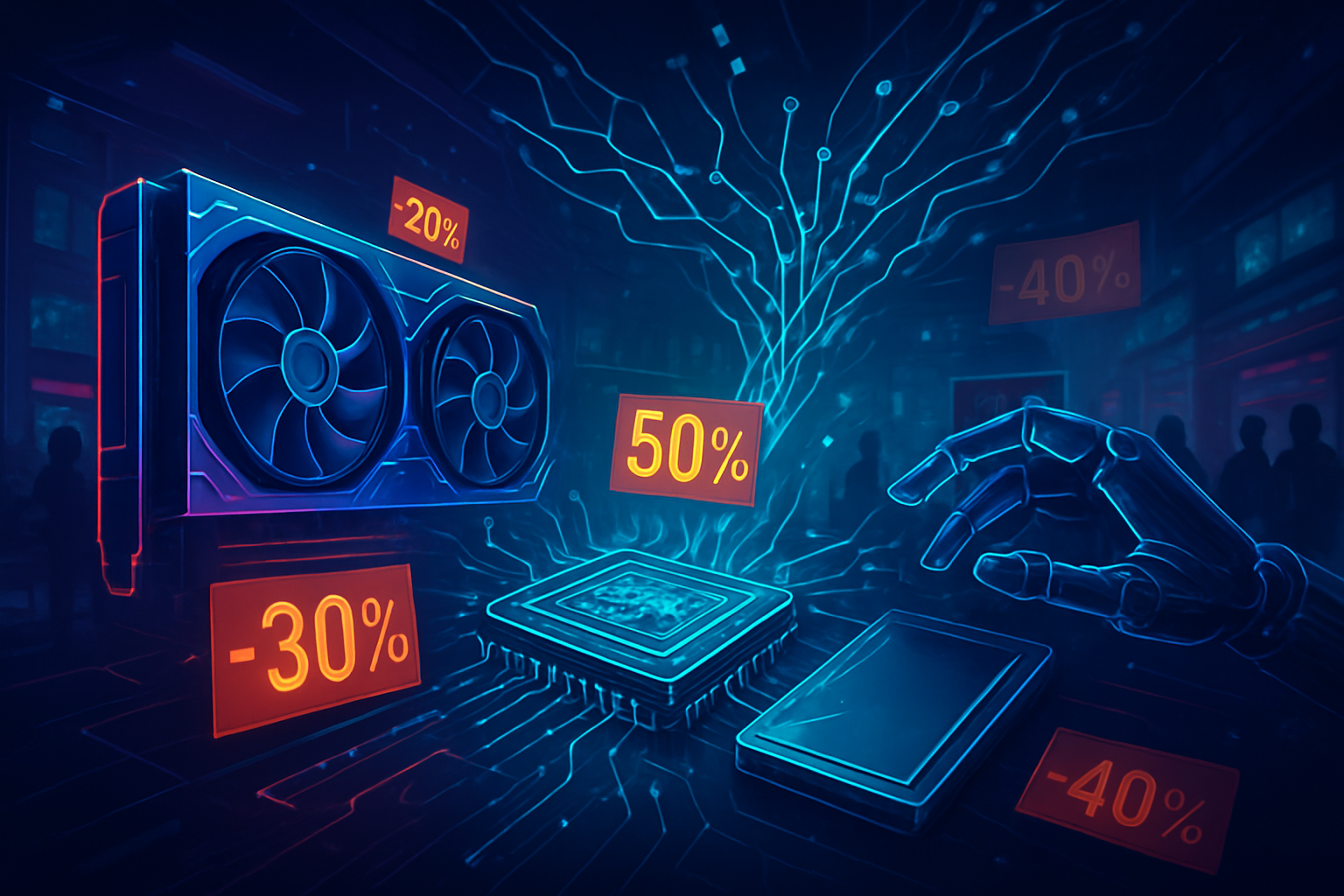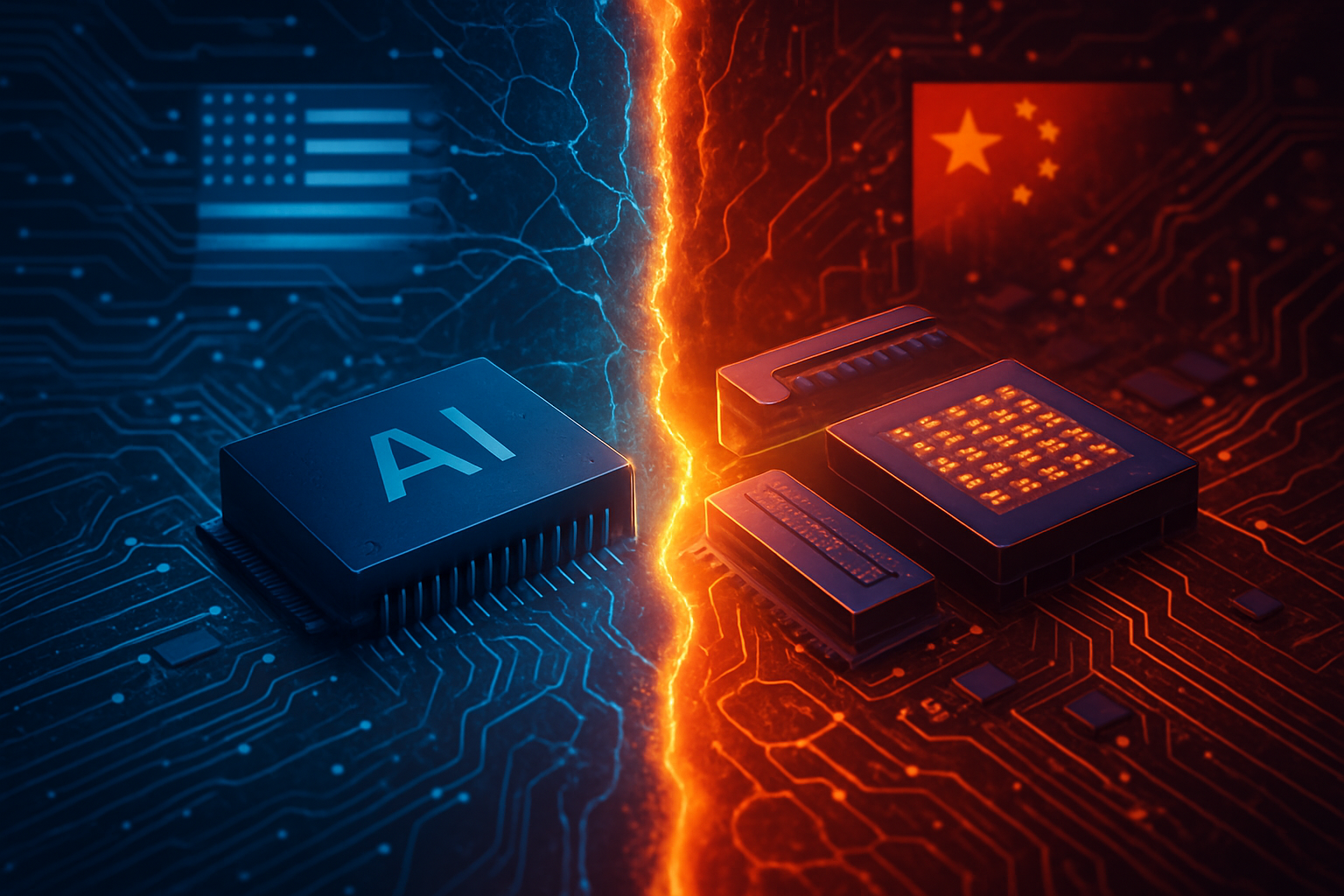Black Friday 2025 has unfolded as a critical period for PC hardware enthusiasts, offering a complex tapestry of aggressive discounts on GPUs, CPUs, and SSDs, set against a backdrop of escalating demand from the artificial intelligence (AI) sector and looming memory price hikes. As consumers navigated a landscape of compelling deals, particularly in the mid-range and previous-generation categories, industry analysts cautioned that this holiday shopping spree might represent one of the last opportunities to acquire certain components, especially memory, at relatively favorable prices before a significant market recalibration driven by AI data center needs.
The current market sentiment is a paradoxical blend of consumer opportunity and underlying industry anxiety. While retailers have pushed forth with robust promotions to clear existing inventory, the shadow of anticipated price increases for DRAM and NAND memory, projected to extend well into 2026, has added a strategic urgency to Black Friday purchases. The PC market itself is undergoing a transformation, with AI PCs featuring Neural Processing Units (NPUs) rapidly gaining traction, expected to constitute a substantial portion of all PC shipments by the end of 2025. This evolving landscape, coupled with the impending end-of-life for Windows 10 in October 2025, is driving a global refresh cycle, but also introduces volatility due to rising component costs and broader macroeconomic uncertainties.
Unpacking the Deals: GPUs, CPUs, and SSDs Under the AI Lens
Black Friday 2025 has proven to be one of the more generous years for PC hardware deals, particularly for graphics cards, processors, and storage, though with distinct nuances across each category.
In the GPU market, NVIDIA (NASDAQ: NVDA) has strategically offered attractive deals on its new RTX 50-series cards, with models like the RTX 5060 Ti, RTX 5070, and RTX 5070 Ti frequently available below their Manufacturer’s Suggested Retail Price (MSRP) in the mid-range and mainstream segments. AMD (NASDAQ: AMD) has countered with aggressive pricing on its Radeon RX 9000 series, including the RX 9070 XT and RX 9060 XT, presenting strong performance alternatives for gamers. Intel's (NASDAQ: INTC) Arc B580 and B570 GPUs also emerged as budget-friendly options for 1080p gaming. However, the top-tier, newly released GPUs, especially NVIDIA's RTX 5090, have largely remained insulated from deep discounts, a direct consequence of overwhelming demand from the AI sector, which is voraciously consuming high-performance chips. This selective discounting underscores the dual nature of the GPU market, serving both gaming enthusiasts and the burgeoning AI industry.
The CPU market has also presented favorable conditions for consumers, particularly for mid-range processors. CPU prices had already seen a roughly 20% reduction earlier in 2025 and have maintained stability, with Black Friday sales adding further savings. Notable deals included AMD’s Ryzen 7 9800X3D, Ryzen 7 9700X, and Ryzen 5 9600X, alongside Intel’s Core Ultra 7 265K and Core i7-14700K. A significant trend emerging is Intel's reported de-prioritization of low-end PC microprocessors, signaling a strategic shift towards higher-margin server parts. This could lead to potential shortages in the budget segment in 2026 and may prompt Original Equipment Manufacturers (OEMs) to increasingly turn to AMD and Qualcomm (NASDAQ: QCOM) for their PC offerings.
Perhaps the most critical purchasing opportunity of Black Friday 2025 has been in the SSD market. Experts have issued strong warnings of an "impending NAND apocalypse," predicting drastic price increases for both RAM and SSDs in the coming months due to overwhelming demand from AI data centers. Consequently, retailers have offered substantial discounts on both PCIe Gen4 and the newer, ultra-fast PCIe Gen5 NVMe SSDs. Prominent brands like Samsung (KRX: 005930) (e.g., 990 Pro, 9100 Pro), Crucial (a brand of Micron Technology, NASDAQ: MU) (T705, T710, P510), and Western Digital (NASDAQ: WDC) (WD Black SN850X) have featured heavily in these sales, with some high-capacity drives seeing significant percentage reductions. This makes current SSD deals a strategic "buy now" opportunity, potentially the last chance to acquire these components at present price levels before the anticipated market surge takes full effect. In contrast, older 2.5-inch SATA SSDs have seen fewer dramatic deals, reflecting their diminishing market relevance in an era of high-speed NVMe.
Corporate Chessboard: Beneficiaries and Competitive Shifts
Black Friday 2025 has not merely been a boon for consumers; it has also significantly influenced the competitive landscape for PC hardware companies, with clear beneficiaries emerging across the GPU, CPU, and SSD segments.
In the GPU market, NVIDIA (NASDAQ: NVDA) continues to reap substantial benefits from its dominant position, particularly in the high-end and AI-focused segments. Its robust CUDA software platform further entrenches its ecosystem, creating high switching costs for users and developers. While NVIDIA strategically offers deals on its mid-range and previous-generation cards to maintain market presence, the insatiable demand for its high-performance GPUs from the AI sector means its top-tier products command premium prices and are less susceptible to deep discounts. This allows NVIDIA to sustain high Average Selling Prices (ASPs) and overall revenue. AMD (NASDAQ: AMD), meanwhile, is leveraging aggressive Black Friday pricing on its current-generation Radeon RX 9000 series to clear inventory and gain market share in the consumer gaming segment, aiming to challenge NVIDIA's dominance where possible. Intel (NASDAQ: INTC), with its nascent Arc series, utilizes Black Friday to build brand recognition and gain initial adoption through competitive pricing and bundling.
The CPU market sees AMD (NASDAQ: AMD) strongly positioned to continue its trend of gaining market share from Intel (NASDAQ: INTC). AMD's Ryzen 7000 and 9000 series processors, especially the X3D gaming CPUs, have been highly successful, and Black Friday deals on these models are expected to drive significant unit sales. AMD's robust AM5 platform adoption further indicates consumer confidence. Intel, while still holding the largest overall CPU market share, faces pressure. Its reported strategic shift to de-prioritize low-end PC microprocessors, focusing instead on higher-margin server and mobile segments, could inadvertently cede ground to AMD in the consumer desktop space, especially if AMD's Black Friday deals are more compelling. This competitive dynamic could lead to further market share shifts in the coming months.
The SSD market, characterized by impending price hikes, has turned Black Friday into a crucial battleground for market share. Companies offering aggressive discounts stand to benefit most from the "buy now" sentiment among consumers. Samsung (KRX: 005930), a leader in memory technology, along with Micron Technology's (NASDAQ: MU) Crucial brand, Western Digital (NASDAQ: WDC), and SK Hynix (KRX: 000660), are all highly competitive. Micron/Crucial, in particular, has indicated "unprecedented" discounts on high-performance SSDs, signaling a strong push to capture market share and provide value amidst rising component costs. Any company able to offer compelling price-to-performance ratios during this period will likely see robust sales volumes, driven by both consumer upgrades and the underlying anxiety about future price escalations. This competitive scramble is poised to benefit consumers in the short term, but the long-term implications of AI-driven demand will continue to shape pricing and supply.
Broader Implications: AI's Shadow and Economic Undercurrents
Black Friday 2025 is more than just a seasonal sales event; it serves as a crucial barometer for the broader PC hardware market, reflecting significant trends driven by the pervasive influence of AI, evolving consumer spending habits, and an uncertain economic climate. The aggressive deals observed across GPUs, CPUs, and SSDs are not merely a celebration of holiday shopping but a strategic maneuver by the industry to navigate a transitional period.
The most profound implication stems from the insatiable demand for memory (DRAM and NAND/SSDs) by AI data centers. This demand is creating a supply crunch that is fundamentally reshaping pricing dynamics. While Black Friday offers a temporary reprieve with discounts, experts widely predict that memory prices will escalate dramatically well into 2026. This "NAND apocalypse" and corresponding DRAM price surges are expected to increase laptop prices by 5-15% and could even lead to a contraction in overall PC and smartphone unit sales in 2026. This trend marks a significant shift, where the enterprise AI market's needs directly impact consumer affordability and product availability.
The overall health of the PC market, however, remains robust in 2025, primarily propelled by two major forces: the impending end-of-life for Windows 10 in October 2025, necessitating a global refresh cycle, and the rapid integration of AI. AI PCs, equipped with NPUs, are becoming a dominant segment, projected to account for a significant portion of all PC shipments by year-end. This signifies a fundamental shift in computing, where AI capabilities are no longer niche but are becoming a standard expectation. The global PC market is forecasted for substantial growth through 2030, underpinned by strong commercial demand for AI-capable systems. However, this positive outlook is tempered by potential new US tariffs on Chinese imports, implemented in April 2025, which could increase PC costs by 5-10% and impact demand, adding another layer of complexity to the supply chain and pricing.
Consumer spending habits during this Black Friday reflect a cautious yet value-driven approach. Shoppers are actively seeking deeper discounts and comparing prices, with online channels remaining dominant. The rise of "Buy Now, Pay Later" (BNPL) options also highlights a consumer base that is both eager for deals and financially prudent. Interestingly, younger demographics like Gen Z, while reducing overall electronics spending, are still significant buyers, often utilizing AI tools to find the best deals. This indicates a consumer market that is increasingly savvy and responsive to perceived value, even amidst broader economic uncertainties like inflation.
Compared to previous years, Black Friday 2025 continues the trend of strong online sales and significant discounts. However, the underlying drivers have evolved. While past years saw demand spurred by pandemic-induced work-from-home setups, the current surge is distinctly AI-driven, fundamentally altering component demand and pricing structures. The long-term impact points towards a premiumization of the PC market, with a focus on higher-margin, AI-capable devices, likely leading to increased Average Selling Prices (ASPs) across the board, even as unit sales might face challenges due to rising memory costs. This period marks a transition where the PC is increasingly defined by its AI capabilities, and the cost of enabling those capabilities will be a defining factor in its future.
The Road Ahead: AI, Innovation, and Price Volatility
The PC hardware market, post-Black Friday 2025, is poised for a period of dynamic evolution, characterized by aggressive technological innovation, the pervasive influence of AI, and significant shifts in pricing and consumer demand. Experts predict a landscape of both exciting new releases and considerable challenges, particularly concerning memory components.
In the near-term (post-Black Friday 2025 into 2026), the most critical development will be the escalating prices of DRAM and NAND memory. DRAM prices have already doubled in a short period, and further increases are predicted well into 2026 due to the immense demand from AI hyperscalers. This surge in memory costs is expected to drive up laptop prices by 5-15% and contribute to a contraction in overall PC and smartphone unit sales throughout 2026. This underscores why Black Friday 2025 has been highlighted as a strategic purchasing window for memory components. Despite these price pressures, the global computer hardware market is still forecast for long-term growth, primarily fueled by enterprise-grade AI integration, the discontinuation of Windows 10 support, and the enduring relevance of hybrid work models.
Looking at long-term developments (2026 and beyond), the PC hardware market will see a wave of new product releases and technological advancements:
- GPUs: NVIDIA (NASDAQ: NVDA) is expected to release its Rubin GPU architecture in early 2026, featuring a chiplet-based design with TSMC's 3nm process and HBM4 memory, promising significant advancements in AI and gaming. AMD (NASDAQ: AMD) is developing its UDNA (Unified Data Center and Gaming) or RDNA 5 GPU architecture, aiming for enhanced efficiency across gaming and data center GPUs, with mass production forecast for Q2 2026.
- CPUs: Intel (NASDAQ: INTC) plans a refresh of its Arrow Lake processors in 2026, followed by its next-generation Nova Lake designs by late 2026 or early 2027, potentially featuring up to 52 cores and utilizing advanced 2nm and 1.8nm process nodes. AMD's (NASDAQ: AMD) Zen 6 architecture is confirmed for 2026, leveraging TSMC's 2nm (N2) process nodes, bringing IPC improvements and more AI features across its Ryzen and EPYC lines.
- SSDs: Enterprise-grade SSDs with capacities up to 300 TB are predicted to arrive by 2026, driven by advancements in 3D NAND technology. Samsung (KRX: 005930) is also scheduled to unveil its AI-optimized Gen5 SSD at CES 2026.
- Memory (RAM): GDDR7 memory is expected to improve bandwidth and efficiency for next-gen GPUs, while DDR6 RAM is anticipated to launch in niche gaming systems by mid-2026, offering double the bandwidth of DDR5. Samsung (KRX: 005930) will also showcase LPDDR6 RAM at CES 2026.
- Other Developments: PCIe 5.0 motherboards are projected to become standard in 2026, and the expansion of on-device AI will see both integrated and discrete NPUs handling AI workloads. Third-generation Neuromorphic Processing Units (NPUs) are set for a mainstream debut in 2026, and alternative processor architectures like ARM from Qualcomm (NASDAQ: QCOM) and Apple (NASDAQ: AAPL) are expected to challenge x86 dominance.
Evolving consumer demands will be heavily influenced by AI integration, with businesses prioritizing AI PCs for future-proofing. The gaming and esports sectors will continue to drive demand for high-performance hardware, and the Windows 10 end-of-life will necessitate widespread PC upgrades. However, pricing trends remain a significant concern. Escalating memory prices are expected to persist, leading to higher overall PC and smartphone prices. New U.S. tariffs on Chinese imports, implemented in April 2025, are also projected to increase PC costs by 5-10% in the latter half of 2025. This dynamic suggests a shift towards premium, AI-enabled devices while potentially contracting the lower and mid-range market segments.
The Black Friday 2025 Verdict: A Crossroads for PC Hardware
Black Friday 2025 has concluded as a truly pivotal moment for the PC hardware market, simultaneously offering a bounty of aggressive deals for discerning consumers and foreshadowing a significant transformation driven by the burgeoning demands of artificial intelligence. This period has been a strategic crossroads, where retailers cleared current inventory amidst a market bracing for a future defined by escalating memory costs and a fundamental shift towards AI-centric computing.
The key takeaways from this Black Friday are clear: consumers who capitalized on deals for GPUs, particularly mid-range and previous-generation models, and strategically acquired SSDs, are likely to have made prudent investments. The CPU market also presented robust opportunities, especially for mid-range processors. However, the overarching message from industry experts is a stark warning about the "impending NAND apocalypse" and soaring DRAM prices, which will inevitably translate to higher costs for PCs and related devices well into 2026. This dynamic makes the Black Friday 2025 deals on memory components exceptionally significant, potentially representing the last chance for some time to purchase at current price levels.
This development's significance in AI history is profound. The insatiable demand for high-performance memory and compute from AI data centers is not merely influencing supply chains; it is fundamentally reshaping the consumer PC market. The rapid rise of AI PCs with NPUs is a testament to this, signaling a future where AI capabilities are not an add-on but a core expectation. The long-term impact will see a premiumization of the PC market, with a focus on higher-margin, AI-capable devices, potentially at the expense of budget-friendly options.
In the coming weeks and months, all eyes will be on the escalation of DRAM and NAND memory prices. The impact of Intel's (NASDAQ: INTC) strategic shift away from low-end desktop CPUs will also be closely watched, as it could foster greater competition from AMD (NASDAQ: AMD) and Qualcomm (NASDAQ: QCOM) in those segments. Furthermore, the full effects of new US tariffs on Chinese imports, implemented in April 2025, will likely contribute to increased PC costs throughout the second half of the year. The Black Friday 2025 period, therefore, marks not an end, but a crucial inflection point in the ongoing evolution of the PC hardware industry, where AI's influence is now an undeniable and dominant force.
This content is intended for informational purposes only and represents analysis of current AI developments.
TokenRing AI delivers enterprise-grade solutions for multi-agent AI workflow orchestration, AI-powered development tools, and seamless remote collaboration platforms.
For more information, visit https://www.tokenring.ai/.









